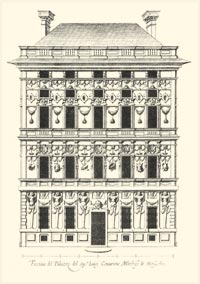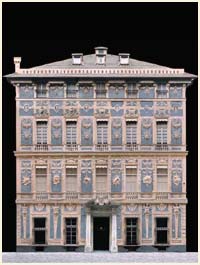The façade of the palace becomes the backstage that introduces and invites the visitor. A totally identical plan for the interior and the exterior was hypothesised and the critics once again trace back to Bergamasco's genius the plan for the façade, enlivened by stucco and anthropomorphic relief alternated with spaces that accentuate the 'pictorial' vibration: festoons, garlands of fruit, grotesque masks, herms, monstrous harpies, shreds, ornaments and ancient style relief all cover the façade that looks on to Strada Nuova, animating the front and giving a touch of human life at the same time.
This front, accurately described by Müller Profumo, is a real exception if compared with the frontage of the other buildings in Strada Nuova, all mainly characterised by an illusive pictorial space. The relief visibly enlightens the façade, which can be perceived by the observer as the 'Ephemeral dressed to party': the tricks, formed by light and shadow that this magnificent stucco creates, enhance the sense of apparent lightness with which these relief forms seem to move.
At ground floor level, between the windows, herms in stucco with androgynous faces appear to be supported by soft drapes; below a claw perhaps reveals their true nature of harpies.
On the first floor we find various weapon trophies, knives, clypei, sword handles, daggers and shields hanging from strips of material, symbolically hint at the moral strength; the windows are framed by delicate spirals, below which the figures of herm-mermaids can be recognised.
On the other hand a series of garlands full of fruit; images of a luxuriant nature and bestower of life enliven the second state floor. Above the windows grotesque masks framed by spiralled scrolls can be found. A space full of emblems, symbols, allusive references and similarities, dressed up in an imaginative way with great visible impact.
The realisation of the whole cycle of stucco, from a design which is likely to be done by 'Il Bergamasco', is traditionally attributed to the artist from Urbino Marcello Sparzo, very productive in Genoa at the end of the sixteenth century in public and private works.
Comparing the present recently restored façade with the drawing published by Rubens, a few changes can be seen: the windows seem to be wider, this maybe due to the construction of the balconies at the beginning of the seventeenth century; on the second state floor there is no longer the mezzanine, and on the first floor the busts which were in the oval cornices above the windows are missing.
Thanks to the latest philological restoration, a thick layer of grey deposit has been removed and the façade has returned to its original splendour. The wide portal used to enter the building today is the result of changes made in the eighteenth century: the original entrance was smaller and simpler, decorated by a sneering mask, as can be seen in Rubens' drawing. Today two smooth columns support a split gable with a large overhang, at the centre of which there is a scroll bearing the initials A.P. on the coat of arms, those of the nineteenth century owner Andrea Podestà.
Without a doubt the changes made in the eighteenth century were due to the desire to give more emphasis to the lavishness and the magnificence of the building's entrance.

P.P.Rubens facade of Palazzo Lomellino, from Palazzi Moderni di Genova, II ed., Antwerp 1626.

Facade of Palazzo Lomellino after the last restoration works.
